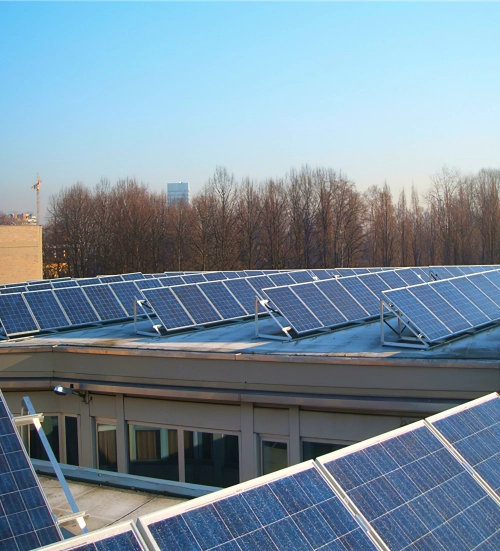
Installation tips for household photovoltaic power stations
2023-12-21
Household solar photovoltaic power stations are small distributed photovoltaic systems, which are generally installed on roofs in China. But what if you think you can install a photovoltaic power plant as long as you have a roof? That would be a big mistake. Photovoltaic power stations, especially solar racks, should fully consider the actual situation in the installation design, follow the principle of economic applicability, be highly reliable, strong and durable, easy to maintain, and fully consider the influence of geographical and climatic environments.
The following are tips on how to install a household photovoltaic power station.
1. Selection of photovoltaic power station installation location
The location of a household photovoltaic power station can generally be chosen on the roof of your home or on an open space. The conditions that need to be considered are the usable area, building structure and load-bearing requirements, ground foundation conditions, meteorological and hydrological conditions, etc. If you choose to install it on your own roof, the roof load-bearing capacity must be greater than 20kg/㎡. In addition, if the beams of the house are made of wood, don’t consider it. The photovoltaic system has a service life of up to 25 years. Wooden beams are easy to rot, so it is recommended not to install it.
The following is a description of the characteristics of roof installation of different structural types:
1. Herringbone structure roof: If a solar photovoltaic power station is built on a herringbone structure roof, it cannot design the optimal inclination angle like a ground power station, and the front and rear shielding distance must be considered. In order to facilitate the integration of photovoltaic modules and roofs, household roof photovoltaic brackets are generally laid directly facing south. The photovoltaic bracket is connected to the roof using clamps, and the battery components are installed on the bracket. This method is not only beautiful, but also maximizes the use of roof area.
2. Flat roof: When building a solar photovoltaic power station on a flat roof structure, it is necessary to consider the flat roof photovoltaic bracket and design the optimal inclination angle and front-to-back spacing of the modules.
3. Your own open space: If you choose to install it on your own open space, you can use anchor piles and concrete strip foundations as the support foundation. The specific choice needs to be considered based on the geological conditions and cost. In addition, the design of the support foundation strength must be based on local meteorological conditions.
It should be noted that taking into account the thermal expansion and contraction effects of components, it is better to have a distance of about 3cm between the upper, lower, left and right components during installation.
2. Selection of grid-connected inverter
Grid-connected inverters are mainly divided into three categories: high-frequency transformer type, low-frequency transformer type and transformerless type. Depending on the system being designed and the specific requirements of the owner, the transformer type is mainly considered from two aspects: safety and efficiency. Household distributed photovoltaic systems are small systems and do not require high technical specifications. When the inverter does not have an isolation transformer, the energy conversion efficiency is higher. Combined with cost and other factors, it is more reasonable to choose the transformerless type.
Lightning protection design
In order to ensure the safety and reliability of the photovoltaic grid-connected power generation system and prevent damage to system components due to external factors such as lightning strikes and surges, the lightning protection grounding device of the system is indispensable. Solar photovoltaic power stations are level 3 lightning protection buildings. Lightning protection and grounding involve the following two aspects:
1. Try to avoid the projection of the lightning rod from falling on the photovoltaic modules.
2. The ground wire is the key to lightning protection and lightning protection. Prevent lightning induction: The metal sheaths of equipment, solar brackets, metal pipes, and cables must be reliably grounded. Each metal item must be connected to the grounding trunk line individually. It is not allowed to be connected in series and then connected to the grounding trunk line.
3. Choose reliable after-sales service
A rooftop photovoltaic power station will continue to generate electricity for no less than 25 years. Whether it is a distributed industrial and commercial rooftop photovoltaic power station of several MW or a household distributed power generation system of several KW, a reliable and complete after-sales service system is particularly important. .
4. Identify the brand and professionalism
First of all, the selection of equipment must ensure quality, especially components and inverters. Do not choose low-priced and inferior equipment just for the sake of cheapness. In this industry, prices are basically relatively transparent. As the saying goes, you get what you pay for. , no one is a live Lei Feng. In daily business negotiations, customers often suggest that a certain company’s price is much lower. For such situations, I can only advise customers to seriously consider, carefully consider, and use their heart to judge and choose a trustworthy photovoltaic bracket manufacturer.
Secondly, the professionalism of the design of the overall system solution and on-site installation cannot be underestimated. In order to maximize profits, some practitioners choose low-priced and inferior equipment to be inferior to good ones. They are also eager for success during the on-site installation process and ignore the details that should be paid attention to during the installation. Can you imagine how such a power generation system can withstand the test of many years? Therefore, you must choose a photovoltaic brand that you can trust!
Solar energy adheres to the principle of the highest quality. All aluminum profiles of solar bracket products are made of AL6005 grade, processed in T5 state, and the surface is anodized at 12-15MIC; all stainless steel materials are grade 304; steel is graded Q235, and the surface treatment is hot-dip galvanized with an average of 80MIC. .
